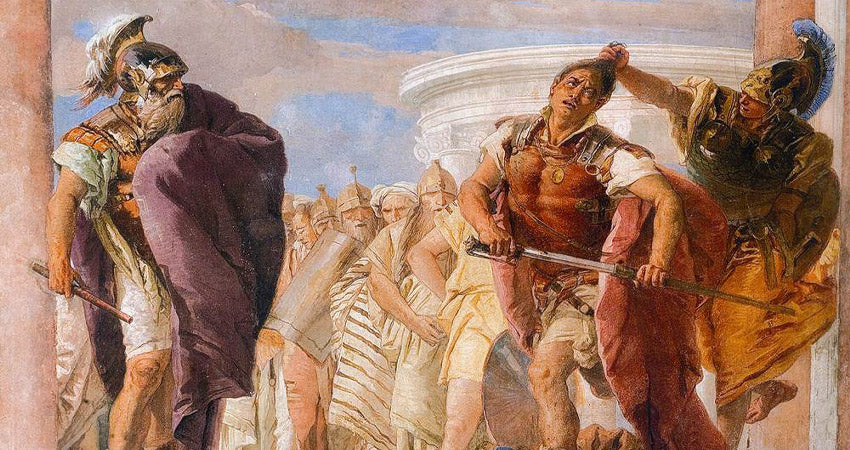
The Wrath of Achilles by Giambattista Tiepolo 1757
Alessandro TrizioShare
"The Wrath of Achilles" by Giambattista Tiepolo, created in 1757, is an extraordinary example of the late Venetian Baroque, a period characterized by highly dramatic and theatrical artistic expression. This painting represents an episode from Homer's Iliad, in which Achilles becomes furious with Agamemnon for the return of Briseis, his beloved slave.
Outraged at having lost his beloved, Achilles draws his sword to kill Agamemnon. The sudden appearance of the goddess Minerva, who in this fresco has grabbed Achilles by the hair, prevents the act of violence. Agamemnon stands on the left and tries to protect himself with his cloak, while in the background, in front of a circular temple, a line of Greek soldiers observes the scene. What stands out in this fresco is the expression on Achilles' face, almost contorted with anger into a grimace, something rarely found in Tiepolo.
DO YOU WANT A REPRODUCTION OF THIS PAINTING? WRITE TO US
Composition and Structure
The composition of the painting is highly dynamic and built on a strong diagonal that runs through the entire scene, creating a sense of movement that immediately captures the viewer's attention. This diagonal line guides the eye from the intensity of Achilles' face through the various characters that populate the scene, adding depth and narrative tension. The arrangement of the figures contributes to a sense of turmoil and disorder, underlining the central conflict of the narrative.
Use of Color and Light
Tiepolo demonstrates his mastery of color with a vibrant and bright palette. Rich, contrasting colors are used to emphasize the drama of the moment, with warm tones highlighting the central figure of Achilles and cooler tones found in the supporting characters and background. Chiaroscuro, or the contrasting use of light and shadow, is used theatrically to bring the faces and expressions of the main characters to life. Areas of bright light draw attention to key elements of the scene, while deep shadows add a sense of mystery and depth.
Expressiveness and Details
Each character in the painting is portrayed with great attention to expressive detail. Achilles, at the center of the work, is depicted with a tense posture and an expression of intense anger, which communicates his fury and pain. Agamemnon, depicted in a defensive posture, is caught in a moment of vulnerability. The secondary characters, who surround the main protagonists, further enrich the visual narrative with their expressions and gestures that reflect shock, fear and curiosity.
Artistic Details
The level of detail in the costumes and armor is remarkable, with Tiepolo paying particular attention to fabrics, textures and ornamentation, adding a further layer of realism and visual richness. This not only shows his technical skill but also his ability to immerse the viewer in the ancient world, making the mythological scene tangible and vivid.
Historical context
"The Wrath of Achilles" was completed in a period of great success for Giambattista Tiepolo. In 1757, Tiepolo worked on commission for the Prince-Bishop of Würzburg, a prestigious assignment that required the decoration of the Residential Palace with frescoes celebrating heroic and mythological themes.
In the 18th century, classical mythology was a rich source of inspiration for artists, and epic stories such as the Iliad provided an ideal repertoire for dramatic performances. The aristocrats of the time loved to surround themselves with works that celebrated values such as honor, virtue and courage, reflecting their desire to identify with the heroes of antiquity.
Giambattista Tiepolo, influenced by the Venetian Baroque and known for his innovative use of light, color and composition, interpreted these themes with a unique sensitivity, combining fidelity to classical sources with a fresh and visually compelling approach. "The Wrath of Achilles" is therefore not only a representation of a mythological episode, but also an example of how the art of the period could explore and celebrate universal themes of conflict, power and human emotion.
This painting remains a testament to Tiepolo's artistic mastery and his contribution to the tradition of historical and mythological painting, influencing generations of artists and art enthusiasts.

